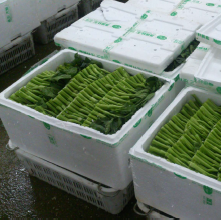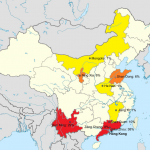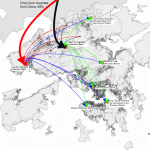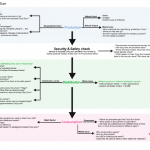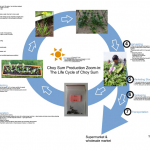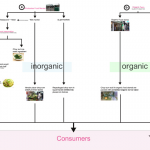Choy Sum
Choy sum (also known as Chinese flowering cabbage) refer to a flowering vegetable which produces thick, crunchy stalks, yellow flowers, and lush green leaves. Being one of the most popular vegetables in china and Hong Kong, it is used in a variety of Chinese dishes, usually stir fries and soups. While choy sum can be easily accessed through supermarkets, wet market farms or restaurant, consumers never know the complexity of the pathways it has gone through behind consumption. This essay traces the path of non- organic grown choy sum backwards from consumption to distribution to product, and makes critical observations on the environmental and social issues in the network.
Types of Choy Sum You Usually Find In Hong Kong
In china, the cultivars of choy sum are classified by the number of days from sowing. The premature choy sum which takes 28-35 days are called ‘49’ cabbage while medium flowering type are regarded as ‘60 days’ cabbage. These are the two common types of choy sum in Hong Kong and have high export rate in China. Lastly, the late-maturing type is March cabbage and they take 55-75 days to grow.
Where Do Choy Sum Come From?
In Hong Kong, 96% are imported from mainland China and 3% are locally grown. Only 1% are international arrivals. Local farms that grow choy sum are located in Yuen Long and West New Territories.
For imported choy sum, though the majority choy sum are still from Guangdong province, there is northward relocation of Mainland vegetable farms in China. As shown in our previous China map, Ning Xia choy sum takes up only 6% in the market while choy sum grown in Mongolia counts around 1-2%. Senior manager of Vegetable Marketing Organization (VMO), Mr Hui revealed, ‘Choy sum raised in northern China will undoubtedly increase in the future.’’
Choy sum is cool season crop. Mr Hui told us in the interview that vegetable are sweeter and more nutritious in the places where temperature varies greatly between nights and days. Ning Xia and Mongolia are provinces at high latitude and the weather and environment perfectly fit for growing choy sum. ‘Ning Xia choy sum is becoming more popular and well-known in Hong Kong since the choy sum taste sweeter.’ said Mr Hui. Besides, because of global market transformations, local production is required to satisfy out-of-
season desire. (Cate Christ 2013, 364-365)Transportation systems in north area have been well-developed while the advancement in technology allows better and longer storage of choy sum. The relocation of farms is an expansion of agricultural corporates. When it comes to summer in south area, agricultural corporates soon move their production line to farms in the north and ensure year round supply of choy sum. So, consumer’s out-of-season desire towards choy sum constitutes the relocation of farms.
Growing Choy Sum – Food Safety Issue
Choy sum can be grown all year round with uniform conditions, moderate moisture levels and reasonable sunlight. The major production processes of choy sum are preparation, planting and transplanting, harvesting, marketing storage and packaging.
Talking about imported choy sum from mainland China, food safety problems is always hot topic being discussed. Indeed, after interviewing Mr Hui from VMO and doing series of intense research, vegetable safety is significantly improved. VMO and AFDC jointly run the Accredited Farm Scheme. Farms are accredited for good horticultural practice and proper use of pesticides. While the scheme used to cooperate with farms in Hong Kong and Guangdong Province, the scheme has also been extended to the Ningxia Hui Autonomous Region recently. As VMO on its website stated, as at 31 March 2012, 296 farms (including 37 farms in Guangdong Province and Ningxia Hui Autonomous Region) covering a total area of 2,760 ha had been accredited. Under the scheme, while having regular inspection on operation of farms, experienced inspectors from VMO are sent to the farm and take sample for testing pesticides level before harvesting choy sum. At the same time, VMO also provide technical supports and agricultural advice to farmers. ‘They teach us how to deal with infected plants better and have more comprehensive disease control’ said Yeung, farmers from accredited farms in Ning Xia. (Yung 2012)
Good Farmer logo are given to accredited farms and make it recognizable for consumers Farmers from Ning Xia farm register for accredited farm
However, choy sum from accredited farms are only transported to C.S.W vegetable wholesale market since VMO is only appointed with the authority to manage that market. For other wholesales market, the sources of the choy sum being imported still remain unknown. As interaction between Hong Kong and mainland china increases, AFDC and The General Administration of Quality Supervision, Inspection and Quarantine (AQSIQ) should work more closely and promote similar schemes together to maintain food (vegetable) safety in China.
Distribution of Choy Sum – Wholesales Food Market in Hong Kong
All harvested choy sum are delivered by trucks from farm to distribution center. It is where vendors from wet market trade with wholesalers and negotiate price.
C.S.W vegetable wholesales food market is managed by VMO. Every transition and trading process as well as waste issue is in charged by VMO staffs. In comparison, Western wholesale food market is more like a self-managed market where department officials do not actually own authority to influence the operation. As senior staff from Western wholesale food market mentioned in the site visit, the market is only a place offered by the government for wholesalers to do business. This has resulted in different practices dealing with local and imported choy sum. One of the clear examples is the difference in dealing with leftover choy sum. As we observed in Western wholesale food market, vendors simply throw vegetables in the trash bin so such organic waste ends up in the landfill. However, in C.S.W market which managed by VMO, as Mr Hui revealed that leftover vegetables are collected and sent to charity or converted into organic fertilizers. It is critical to see management of a wholesale market is important in maximizing the use of food and effectiveness in food transition.
On the other hand, Mr Hui has raised his concern about difficulty wholesale market is facing – trades made in wholesale market are actually dropping. First, sales of food in mainland are better than Hong Kong. There is a much bigger demand in the domestic market as people become wealthier in China. Second, some importers have built personal relationship with local vendors from the wet market. By pass distribution increases while more and more vendors order food directly from importers. Lastly, the hardest challenge is the domination of supermarkets which enjoy by-pass distribution from the importers. Business of wholesale market is reducing while the food system of choy sum is progressively monopolized by supermarkets and corporate importers.
Fire Dance own a big choy sum in mainland china and is one of the biggest vegetable importer from mainland. They do supply choy sum to C.S.W market. Packed choy sum in Wellcome which is supplied by Fire Dance. This is a typical example of bypass distribution – Wellcome order choy sum directly from Fire Dance
Waste in Consumption
Consumers get choy sum from various retailers. Usually people get choy sum from wet market and supermarket while some may directly order from local farmers.
As choy sum is ingredients for many Chinese dishes, so restaurant and hotels are actually big customers to wholesalers and importers. However, not all dishes need to use the whole choy sum. Shared by my aunt who has been working in Chinese restaurant for 30 years, she revealed that many choy sums are chopped away from leaves. While the stalks are used in doing fried rice or other dishes, they would just throw away the leaves. Similarly, staffs in restaurants and supermarkets are not allowed to take the leftover food back home. If they do, they are considered as thief stealing food. In developed countries, more than 40 per cent of the losses happen at the retail and consumer end of the food chain. (Chan 2012) When considering the waste issue in consumption level, company culture of big food corporate and supermarket have been producing many avoidable wastes. Why don’t supermarkets donate those yellowish choy sums they consider as unsellable to the needy? Why don’t restaurants allow staffs use the choy sum leaves to cook their lunch?
To the future…
As Mr Hui mentioned, the whole food trade of choy sum from harvest to retail can take almost 100 hours. The network of choy sum is big and complex and it has gone through many different processes to reach to our mouth. There are problems occurred in the food system, but ultimate problem we have to face is commodification of food. Food, what we consider as basic human right, has become nothing but commodity to make money. It changes people’s values, business practices, ways of production and many other processes in the food path. As individual, we have limited power. But it is important for us to first acknowledge and be aware of the complexity of food system. Then we can consume food more consciously and environmental friendly.

